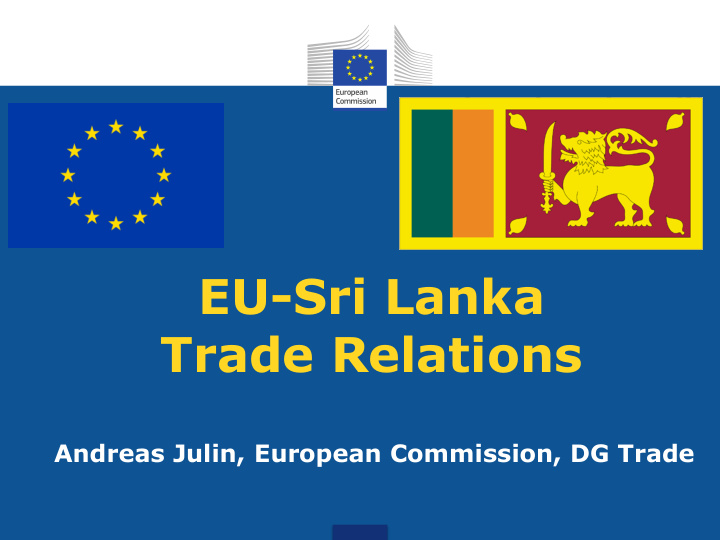



EU-Sri Lanka Trade Relations Andreas Julin, European Commission, DG Trade
Presentation: EU-Sri Lanka Trade Sri Lanka and EU GSP Promoting Bilateral Trade
• EU-Sri Lanka relations are Sri Lanka's Major Export Partners governed by their Cooperation Rank Partner Mio euro Share % Agreement from 1995. World 8.084 100,0% 1 EU 2.094 25,9% • Trade and investment United States 1.745 21,6% 2 important part of the India 428 5,3% 3 relationship. 4 Russia 256 3,3% United Arab 209 2,6% • Bilateral trade has remained 5 Emirates strong over the years. • The EU is Sri Lanka's largest EU's Major Trading Partners export market taking almost Rank Partner Mio euro Share % World 3.386.505 100,0 26% of Sri Lanka's exports to 1 USA 515.996 15,2 the world. 2 China 467.404 13,8 • Sri Lanka ranks as the EU's 3 Russia 285.505 8,4 65 th trading partner and 3 rd 4 Switzerland 238.451 7,0 5 Norway 134.142 4,0 largest in South Asia. .. 65 Sri Lanka 3.833 0,1
• Bilateral trade has developed positively over the years. • Sri Lanka has a trade surplus with the EU of over € 1 billion. • Between 2009-2014 imports from Sri Lanka had an annual average growth rate of 4.7% • EU exports to Sri Lanka grew by 10% on average.
• Composition of trade has remained relatively stable • Main imports from Sri Lanka: clothing, rubber products, coffer/tea and bicycles. • Main exports to Sri Lanka: machinery products, transport equipment, textiles and chemicals
Sri Lanka and EU GSP • Sri Lanka has benefited from the EU's GSP since its inception in the 1970's. • In 2004 Sri Lanka received enhanced GSP preferences under the so called "Labour Regime" for implementing ILO core conventions. • In 2006 Sri Lanka transitioned into the then existing GSP+ scheme. • In 2010 Sri Lanka was removed from GSP+ due to non-effective implementation of 3 UN human rights conventions. • At the moment Sri Lanka benefits from normal GSP.
Impact of losing GSP+ • Analysis indicates: Total imports continued to grow and even performed better than during the GSP+ period. Total preferential imports saw negative growth after GSP+ removal. Total imports of clothing (CH 61-62) also continued to grow positively and also did better than during the GSP+ period. Preferential imports of clothing dropped. Both total and preferential imports of fish (CH 03) and bicycles (CH 87) decreased after the loss of GSP+. Rubber products (CH 40) saw no impact (non-sensitive product) How to isolate from other factors, e.g. depressed economic situation in the EU.
Promoting Trade and Investment • EU Export Helpdesk http://exporthelp.europa.eu/thdapp/index.htm# • Trade Related Assistance
Export Helpdesk One-Stop-Shop for Info on EU Market Requirements Tariffs Understanding the EU market • Binding Tariff Information • Sanitary and phytosanitary • Duty relief and suspensions • requirements • Quotas Environmental requirements • • Antidumping Technical requirements • • Tips & tricks on EU tariffs Marketing standards • Import restrictions • Tips & tricks on EU requirements • Preferential arrangements Statistics • Rules of origin • EU trade flows inside & outside Europe • Generalised Scheme of Preferences (GSP) • Free trade agreements • Autonomous trade regimes • Customs Unions
Trade Related Assistance Programme being developed to promote: Development of a comprehensive Export Trade Strategy; Trade Facilitation; Compliance with quality standards and Sanitary and Phyto-Sanitary (SPS) measures; and Sector Specific Value chain development and SMEs' integration into regional and Global value chains.
Recommend
More recommend